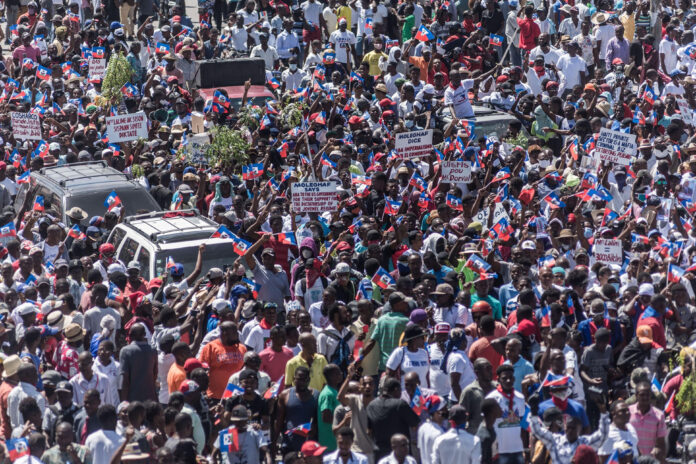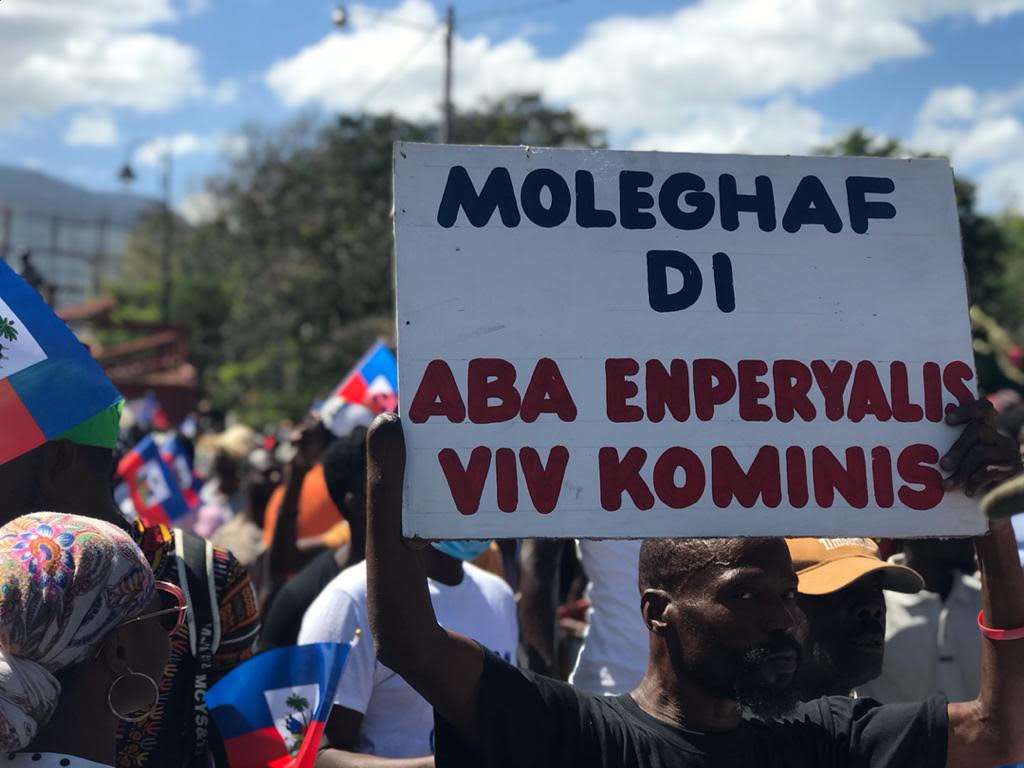
The day begins the night before. The cadre of hope dodge sleep and the police. Under the cover of night and the ancestors, they spray-paint the walls of Port-au-Prince to encourage communities to unite and rise up: “Aba enperyalis, Aba Jovenel!” (Down with imperialism! Down with Jovenel.) “PHTK, Bann volè.” (The PHTK – Haitian Bald Headed Party – is a bunch of thieves.) “Kote kòb PetroCaribe?” (Where is the PetroCaribe money?)
The young writers of the People, Poetry, Revolution collective go deeper, emblazoning the walls of alleyways and main boulevards with short poems. “Powèt, ekri chante k ap ede nou rete debou sou miray lavi sa k ap disparèt.” (Poets, write songs, which help us to stay standing up, on this wall of life which is disappearing.) That poem was spray-painted in black by its author Ricardo Boucher on an alleyway wall in the hilltop Port-au-Prince shantytown of Fort National.
It is Sun., Feb. 28 or Sun., Mar. 7. Sundays are when the showdowns take place between David versus Goliath, the most forgotten versus the empire. There are national mobilizations against the emerging dictator Jovenel Moïse, whose constitutional mandate (if he ever had one) ended three weeks ago on Feb. 7.
As the indefatigable sun rises over Port-au-Prince, families boil akasan (cornmeal) and chokola cho (hot chocolate) in massive pots. They dip their fresh bread into the delicious, scalding, sweet concoctions, focused on the long day ahead.

This is a family affair. They gather in the alleyways (koridò) to make hundreds of signs. “Sison + La Lime = Corruption in Haiti” says one, referring to U.S. Ambassador Michele Sison and Helen La Lime, head of United Nations Integrated Office in Haiti (BINUH). “Hands off Haiti’s Democracy,” says another. Haitians are polyglots. They know who the enemy is, and they speak directly to them. “U.S., UN and OAS: Hands Off Haiti” and “Haiti Can’t Breathe” say two others. The battle of ideas plays out in Port-au-Prince in many languages because Haitians know what many of us perhaps do not: this is an international and anti-imperialist struggle.
This latest democratic struggle is now in its fourth decade. “AYITI PA POU VANN NI AN GWO NI AN DETAY” (Haiti is not for sale, either wholesale or retail) is a slogan often written and chanted since Jean-Claude “Baby Doc” Duvalier fled Haiti on Feb. 7, 1986, the date marking the start of this historical chapter. It is a slogan again today.
At 11 a.m., the protestors start to gather on the Champs de Mars, the capital’s main square. The mobilization’s leaders make their rounds, pumping up the people. The march takes form.
They soak tires in gasoline, and, wufff , the lines are drawn, and the march is off.
Young men take a shot of Barbancourt rum to stave off hunger. There is no fear or anxiety to stave off. No such luxuries. This is a people born into struggle.
The rolling mass picks up momentum and members as they go. Suddenly 1,000 is 5,000. As they roll down Avenue John Brown (it’s telling that Haiti’s most important thoroughfare is named after the militant abolitionist), there are now tens of thousands. The crowd swells and blankets dozens of city blocks.
Delmas is a crucial intersection. South spells trouble where paramilitary kidnapping gangs battle social movements for hegemony. North is the move.
Will this be the day that chodyè chavire (the pot spills over) and the masses again overthrow a petty, second-rate, foreign-sponsored tyrant like they did in 1986?
The police are more careful with mass marches. They are far outnumbered. The neocolonial boomerang can swing back around.
At Delmas 32, the police make their move and attack the front of the march. Tear gas and plastic bullets send everyone sprinting for cover. Stampedes threaten to leave some behind but a helpful hand scoops them back up. Men anpil, chay pa lou. (Many hands lighten the load.)
The rolling mass picks up momentum and members as they go.
Who is covering the story? History is in motion. Where is the BBC? CNN? The New York Times?
“This is not Hong Kong or Taiwan,” one marcher reminds us. “We are a neocolony,” chimes in another.
The Haitian National Police do not discriminate. They pounce upon massive marches or smaller youth-led marches. Their job is to discourage, disrupt, disburse, and dismantle. Tear gas, bullets. The masses are in retreat. Depending on the angles and specific terrain, the bravest throw back the tear gas, rocks, and whatever other makeshift weapons the streets provide.
This is when it gets dangerous. The policemen’s faces are covered and not because they fear COVID. They display no badge numbers nor license plates. They attack without fear, with impunity.
The united march has now scattered in different directions. Contingents play cat-and-mouse with the police trying to outmaneuver them. Anti-imperialist organizations whisk away their top leadership. It is too easy for them to be kidnapped or assassinated. The cadre of hope must live to fight another day.
At 4:30 p.m., a young 25-year-old community leader, Jean Réné “Chata” Laporte, is shot with a bullet. His comrades encircle him and evacuate him to safety. They rush him to the hospital but are careful lest the police take a second shot at him.
The popular organizations reassemble in their neighborhoods. Here they are safe. The police and kidnappers do not run these alleyways. The popular educators check in on one another. Who is injured? Who is caring for Chata? At 7 p.m., they debrief. They debate. They plan. They yell. The passion of centuries of resistance fills the humid air. “Who was responsible for the security breach?” asks someone. “We can’t afford any more dead.”
The struggle against dictatorship and neocolonialism continues…
Danny Shaw, a CUNY professor, slept, ate, and marched with militants from the Fort National neighborhood’s popular organization MOLEGHAF in late February and early March. He tweeted his experiences and reflections at @dannyshawcuny.










[…] May 2022, MOLEGHAF , a Communist party, also withdrew support . In a recent interview , MOLEGHAF’s leader David […]
[…] sin esperar a alcanzar un consenso más amplio y sólido de la sociedad civil”. En mayo de 2022, MOLEGHAF , un partido comunista, también retiró su apoyo . En una entrevista reciente , el líder de […]